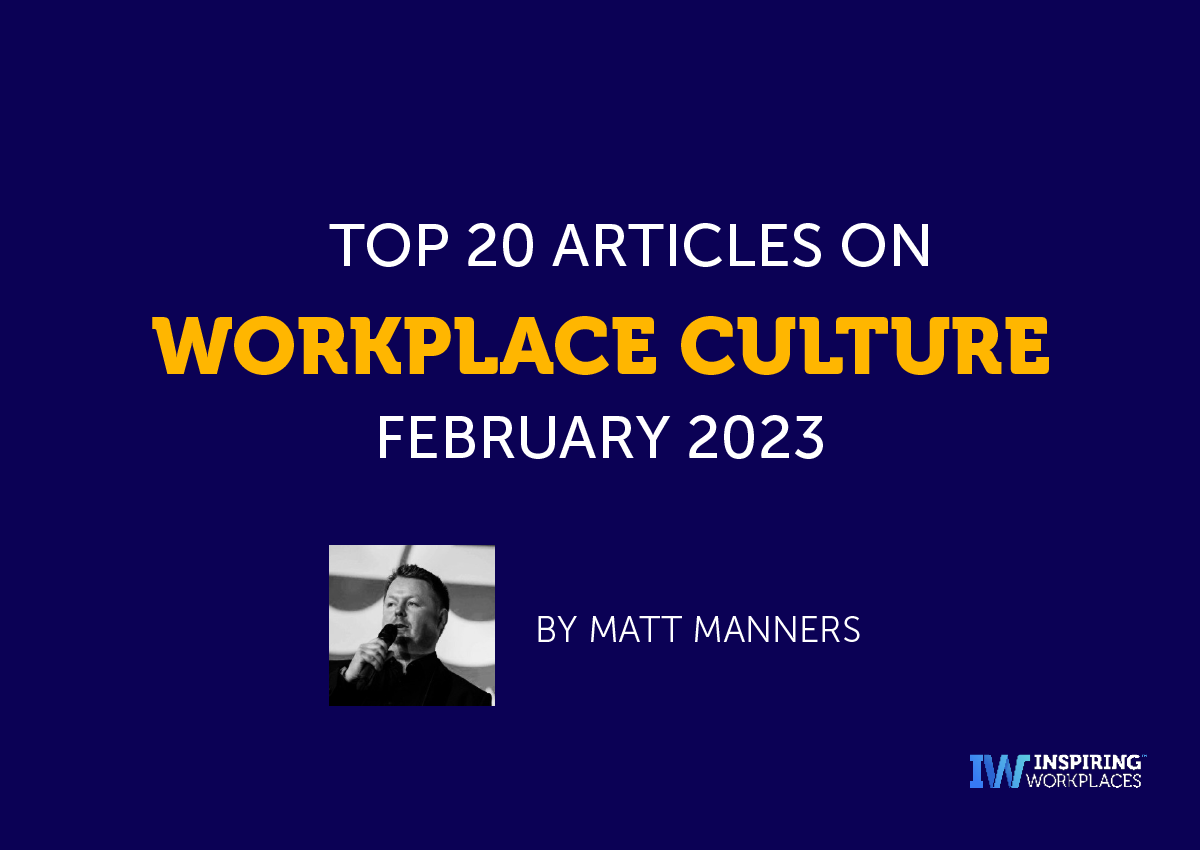
13th March 2023
Top 20 Articles on Workplace Culture for February 2023

Welcome to the Inspiring Workplaces Top 20 Articles on Workplace Culture for February 2023.
We want to help inform and inspire you from some of the best content out there. Each month we will consolidate these articles for you to help give you a quick and easy snapshot. To help drive you and your organisations forward.
The articles will be underpinned by six key elements that are reflected in our awards. They are:
- Wellbeing
- Culture
- Leadership
- Inclusion
- Employee Engagement
- Communication
One in four employees ‘feel like outsiders’ at work
By: Editorial Team
Source: HR Grapevine
Read the full article here.
Our key takeaways for you:
- More than a quarter of U.K employees feel like outsiders at work, with a third not considering their workplace to be a ‘community’, according to new research.
- This is despite 65% of U.K. employees wanting to feel a strong sense of belonging at work.
- These are the findings from O.C. Tanner’s 2023 Global Culture Report which collected and analysed the perspectives of over 36,000 employees, leaders, HR practitioners, and business executives from 20 countries around the world, including 4,653 from the U.K.
- According to the report, there are eight key factors that provide a workplace with a strong sense of community, including shared goals, commitment, communication, feedback, camaraderie, trust, adaptation and unity. Of these, U.K. employees ranked camaraderie/relationship with team members as the most important aspect for nurturing belonging (cited by 73% of respondents).
- The findings reveal that organisations that score high on the ‘community index’ are 100% more likely to have employees that produce aspirational levels of great work, with a 58% lower probability of their employees actively looking for another job
- Despite such compelling reasons to build a workplace community, just 52% of U.K. employees believe that creating a community is a priority for their organisational leaders.
WHAT ARE THE BENEFITS OF MINDFULNESS IN THE WORKPLACE?
By: Emily May
Source: Niagara Institue
Read the full article here.

Our key takeaways for you:
- According to the former director of the Oxford Mindfulness Centre, “mindfulness means knowing exactly what is going on inside and outside ourselves, moment by moment.” What once was a Buddhist practice has evolved over time leading to its boom in popularity, especially in the western part of the world.
- So, does the popularity of mindfulness in the workplace match its perceived benefits? Based on our research of studies conducted around the world by experts in a wide array of disciplines, the answer is yes. Let’s dive into some of those benefits.
- INCREASE FOCUS: With so much going on around us, it can difficult to feel truly focused on the work in front of us. Fortunately, research has found that improving mindfulness can help with that. In fact, mindfulness training was found to improve “reading-comprehension scores and working memory capacity, while simultaneously reducing the occurrence of distracting thoughts. […] Our results suggest that cultivating mindfulness is an effective and efficient technique for improving cognitive function.”
- IMPROVES COMMUNICATION: Effective virtual or face-to-face communication is necessary to nearly any individual’s success on the job, though particularly so for those in leadership roles. Fortunately, research indicates a positive correlation between mindful leaders and their employees as leaders communicate in a way that shows servant leadership behaviors such as “humility, standing back, and authenticity.”
- REDUCES CONFLICT: In a co-study conducted by the UBC Sauder Business School and the University of Minnesota, it was noted that interpersonal conflict at work can affect social relationships, thereby undermining an individual’s behaviors and harming any teamwork.
- INCREASES HELPFULNESS: In the research study, Helping Others by Being in the Present Moment: Mindfulness and Prosocial Behavior at Work, conducted by five international education institutions it was found that mindfulness made people more helpful at work. “They were more generous in the amount of time and the amount of money they would give to their co-workers. Money to co-workers means that there was a donation because somebody was sick at work and you’re contributing to their fund.”
- INCREASES EMOTIONAL INTELLIGENCE: Mindfulness has been found to significantly facilitate the development of emotional intelligence as it helps us understand our own emotions, detect and understand the emotions of others, and develop feelings of closeness and relatedness to those around us.
- REDUCES BURNOUT AND INCREASES PRODUCTIVITY: There are countless studies out there that link practicing mindfulness to reduced stress. But did you know it can also reduce the burnout employees feel and subsequently increase their productivity at work? A study was conducted in a chemical company in which 90 employees participated in different forms of mindfulness training. While employees noted reduced stress and burnout, amazingly the study was able to calculate that the organization could save up to $22,000 per employee as a result of reduced burnout and increased productivity.
- CONTRIBUTES TO ONE’S PHYSICAL HEALTH: Last but certainly not least, improving mindfulness has been linked to several physical health benefits. So while improved productivity, teamwork, and emotional intelligence are valuable, one can argue if we are unwell, none of it really matters. Benefits to our physical health when practicing mindfulness include lower blood pressure, reduced risk of a stroke, reduced risk of heart disease, improved immune system, reduced body dissatisfaction and increased feelings of self-worth.
Surge In Remote Working Fuels Record Employment For People With Disabilities
By: Don Lee
Source: Disability Scoop
Read the full article here.
Our key takeaways for you:

- After generations of being overlooked and sidelined in the job market, Americans with disabilities are enjoying an unprecedented employment boom — thanks to the COVID-19 pandemic.
- Widespread acceptance of remote working and an overall labor shortage have opened up historic opportunities for some of the nation’s most skilled and underutilized workers.
- The question now is whether people with disabilities can hold on to those gains as a recession looms and more employers press their employees to come back to the office.
- Since the pandemic began, employment of people with disabilities is up nearly 25%, to more than 7.3 million workers in November, according to the Bureau of Labor Statistics.
- The jobless rate for workers with disabilities — typically in double digits and 12.3% two years ago — dropped to 5.8% in November. While that’s almost double the rate for all workers ages 16 and over, it represents the lowest rate for people with disabilities since record-keeping began in 2008.
- “It’s been a total game changer,” said Mason Ameri, an associate professor at Rutgers University who has been monitoring disability employment. The shift to telework, he noted, has been particularly helpful for people with physical difficulties and mobility limitations. “The ability to get to work via this 10-second commute is to their advantage,” Ameri said.
- Yet for all the gains made since the pandemic, disability rights advocates say many capable people with disabilities remain unemployed or underemployed because employers fear they will be too costly or lack adequate services to support their employment. Workers with disabilities worry that the momentum built will be lost now that the economy is turning down.
- Layoffs of all kinds of workers have been increasing of late, hitting many people who had worked from home. And a growing number of companies are instructing their employees to return to the office, at least part time.
- The ADA requires employers to offer reasonable accommodation to employees with a disability. Since the law’s enactment in 1990, there have been persistent disputes over what “reasonable” means.
- COVID-19 has also sparked new disputes over what constitutes a qualified disability under the law.
- During the pandemic, millions of people stayed home from work because of underlying health conditions that made them more at risk of serious harm from contracting the virus. And a COVID-19 infection resulted in lingering physical and mental health issues for many people.
- While the pandemic has awakened more employers to the untapped pool of workers with disabilities, 3 out of 10 today don’t have a process to provide requested accommodations, according to the Kessler Foundation’s employment and disability survey with the University of New Hampshire.
- Many experts say that corporate America’s movement on diversity and inclusion doesn’t regard disability status as being a priority as important as race and gender.
The Power of Clarifying Questions – And How to Improve Team Conversations
By: Gustavo Razzetti
Source: Fearless Culture
Read the full article here.
Our key takeaways for you:

- The quality of your team’s conversations is directly correlated to the questions people ask. It has never been more important to facilitate fruitful discussions. Unfortunately, proper questioning has become a lost art. The rush to act now – to keep up to speed with the fast-moving world – leads us to poor decision-making.
- Great leaders avoid jumping to conclusions or assumptions; they rely on powerful questions to understand the facts before passing judgment. Clarifying questions help leaders understand what others are saying – they can better understand a problem, identify new solutions, and evaluate alternatives.
- In today’s world, organizations need to think more than ever. Regardless of whether you are a leader or team member, active listening can improve communication and, above all, collaboration.
- Good listening is not about being a passive observer engaging in fruitful conversations. Questions turn the “speaker versus hearer” division into a dialogue, making everyone feel heard and thrilled.
- Questions make your colleagues feel supported and help them refine their ideas or opinions. Good listening is a cooperative conversation.
- Asking questions means you want to learn. They improve dialogue and minimize any misunderstanding, confusion, or ambiguity. Clarifying questions help us become better listeners by encouraging us to seek more information, rather than assuming we understand.
- Clarifying questions also provide feedback to the speaker, indicating which parts of their message were unclear.
- There are two types of clarifying questions:
- Open questions: They ask the speaker to elaborate on a certain part of their message. Most of them have the form of when, why, where, or how types of questions and encourage the speaker to openly expand their thoughts and ideas.
– Validation questions: They simply reiterate a part of the message and invite the speaker to confirm or not what or whether the listener understood. - Clarifying and Probing:
– Probing questions can come across as confrontational or critical, discouraging open dialogue.
– Clarifying questions provide a pause, delaying the urge to jump to reactions, while probing questions offer judgment. We want to encourage the first and avoid the latter.
Unfortunately, people usually use probing questions when presented with a new concept or opinion – very few teams leverage the power of clarifying questions. - Great questions aim not to judge what’s been said but to keep the conversation going. Often, at work, we minimize, underestimate, and even attack other people’s ideas because we got them all wrong. We end up judging our interpretation of the idea – not what the other person actually said.
- Clarifying questions help team members truly listen to each other. Some of their benefits are:
– They help you clarify instructions from your manager or colleague
– They allow you to fill in the gaps so you can understand the whole picture
– They encourage speakers to be clearer and more specific
– They promote a fluid dialogue between speakers and listeners
– They train you to practice active listening - Research shows that the demand for executives who listen empathetically, welcome input, and rally people around a shared future is increasing.
- Asking clarifying questions is a choice to go beyond the superficial. Getting more information, details, or context prevents your team from making poor decisions. It encourages us to assume positive intent – rather than judging, we want to learn more.
- This is crucial to turn feedback into a gift. Feedback givers should ask questions to help the receiver reflect on the feedback received; receivers must use clarifying questions to ensure they got the right message instead of jumping to conclusions.
- Clarifying questions are also a good way to properly understand the nuances of someone’s opinion. By asking open clarifying questions, the listener pushes the speaker to explain their thoughts or elaborate on their ideas – usually ending in an improved version of the original concept.
- Often, a set of questions can help you tackle a large problem in small chunks. Follow-up questions make it easier to understand a complex problem or solution. Great ideas are the result of smart questions, while fixed statements often justify our resistance to change. Use clarifying questions to stretch beyond your comfort zone.
- Great questions can help challenge not only your assumptions but also those of the idea owner. It’s natural to fall in love with one’s thoughts and fail to see what’s missing. Great clarifying questions help people reflect not only on the solution but also on how and why it was created.
- Good leaders think like good detectives: they use questions to get to the truth, often tapping into distinct sources. Gathering information from diverse sources is vital to make effective decisions – and to drive innovation. Clarifying questions help receivers better understand someone else’s thoughts or opinions by encouraging active listening. Asking clarifying questions elevates the quality of the conversation, welcoming the team to think like detectives.
- A study of over 8,000 people found that virtually all respondents believed that they communicate as effectively or more effectively than their co-workers. How can it be possible that everyone is above average? It’s simple: we all overrate our ability to be good listeners. On average, we all listen at only about 25% efficiency.
- Great leaders lead with questions, not perfect answers. They tap into collective wisdom, leveraging people’s unique views, backgrounds, and expertise.
- Clarifying questions support learning, decision-making, and conflict resolution. They invite in new information, provide transparency, and get everyone on the same page. They can help your team reframe problems, generate new solutions, and evolve existing ones.
- Most importantly, clarifying questions help build trust by replacing judgment with curiosity.
7 Small Ways to Be a More Inclusive Colleague
By: Nikita and Dr Grace Lordan
Source: Harvard Business Review
Read the full article here.
Our key takeaways for you:

- Helping to increase inclusivity at your workplace doesn’t necessarily require an extensive DEI campaign. It also doesn’t require you to be in a position of power. Each and every one of us can decide to be an inclusive colleague and take small actions every day to improve our workplace culture.
- By making small changes in your own behavior, you can generate disproportionate positive effects on your colleagues’ workplace experience. Similar to small deposits earning interest in a long-term savings account, your actions will have large impacts over the longer term.
Here are seven small actions you can take to be a more inclusive colleague and help foster a comfortable and safe work environment for everyone. - Highlight others’ contributions: Visibility at work allows individuals to showcase their abilities, be known to decision makers, and build relationships. Research validates that the contributions of disadvantaged groups, like Asian minorities in Western countries, are systematically overlooked.
- Use your pronouns: Including your pronouns when you introduce yourself at meetings is a small action that signals that you’re an ally to colleagues who may struggle to voice that they’re often referred to with pronouns they don’t identify with. It also normalizes the practice for your other colleagues.
- Use gender-inclusive language: Research has shown that using gender-inclusive language at work is associated with better well-being for employees who identify as LGBTQ, so ensure that the language you use is gender-neutral. For example, using “people” instead of “guys” can make everyone feel included.
- Assess your vocabulary: Many common slang words have other connotations or origins and should be avoided. For example, the word “lame” is often used to describe something as boring or monotonous, but it was originally used to refer to individuals with impaired mobility. Similarly, the common use of the terms “tribalism” or “tribal mindset” to describe out-group behavior is based on a racial stereotype of Indigenous people during colonial times. Actively assess your vocabulary for slang terms that alienate others.
- Celebrate with your colleagues: A diverse workplace is made up of people from various backgrounds who celebrate different festivities, be they religious (like Eid for Muslims) or historic (like Pride or Black History month). Enabling others to celebrate these occasions and participate in organized events is a wonderful way to acknowledge individualism. Even better, celebrating these occasions along with your colleagues can go a long way toward making them feel accepted and boosting their morale, in addition to building psychological safety.
- Get creative about team bonding: While putting together team-bonding activities, factor in the availability and interest of all your team members. If every social event is drinks at a pub in the evening, that might hinder participation from some caregivers, parents, remote employees, and people who don’t drink alcohol. Ensuring that everyone gets to participate in as many team activities as possible will help the team truly bond and have fun together.
- Be curious: Schedule coffees and lunches with colleagues who have different backgrounds than you. Without being intrusive, take an interest in their lived experience inside and outside the office. Use what you learn to devise additional small actions to undertake as an inclusive colleague.
- To foster inclusion around you, form and regularly practice inclusive behaviors until they become habitual and automatic. Starting with these small actions can enable you to transform the level of inclusivity in your team.
How widespread could the four-day workweek really be?
By: Joanna York
Source: BBC Worklife
Read the full article here.
Our key takeaways for you:

- The idea of a four-day workweek used to be such a pipedream that it was barely on the radar for most workers and firms. But in the wake of the Covid-19 pandemic, many companies around the world have given this this set-up a go – and gathered promising results.
- In the US and Ireland, a six-month trial among 33 volunteer companies in 2022 showed a positive impact on company performance, productivity and employee wellbeing.
- Employees working the shortened week reported less stress and fatigue, plus improved work-life balance and satisfaction. The 27 companies that submitted a final survey rated the trial a nine out of 10.
- In a 2022 UK trial of 70 firms, 86% of companies said the four-day week was such a success, they planned to keep it in place after the pilot ended. They cited benefits such as increased productivity and significant financial savings for employees on transport and childcare.
- Similar trials in Belgium, Spain, Japan, Australia and New Zealand have thrown up equally promising results for companies. And – unsurprisingly – employees seem especially keen to make shorter working weeks the norm.
- Yet despite the overwhelmingly positive data, a four-day workweek still seems out of reach for many workers.
- Technology and office-based industries have made the greatest inroads into reducing work hours so far. While a mindset of agility and innovation is often baked into such companies, they also have an advantage in terms of easy, time-saving solutions. Measures such as introducing meeting-free days can enable employees to focus purely on productivity and radically reduce work hours, while concurrently maintaining output – something far easier to do in nimble organisations.
- In the current workplace, some important predictors of whether an organisation is likely to successfully implement a shorter working week may be company size and culture. So far, few major international companies have run trials of the four-day workweek.
- But in companies of all sizes, a certain type of manager could also be resistant changing entrenched norms – a significant barrier to the implantation of shorter weeks. Although the global movement in support of the four-day week is gathering pace, it is not yet a mainstream work practice, and undertaking such progressive change requires a high level of trust between leaders and workers.
- If managers don’t trust that employees can make a success of the change, they are unlikely to want to even test it. (Notably, productivity-related trust issues have been a major problem for managers throughout the pandemic.)
- In cases where four-day workweeks have proven unpopular among employees, a common issue has been reports of managers intensifying performance measurement, monitoring and productivity pressures. So, although many workers cite better wellbeing in some areas, the result of these added elements can spike worker stress levels.
- Even facing resistance from some leaders, experts say it is likely the four-day week will become more mainstream.
- For now, the shorter workweek may not be widespread, but there’s momentum around the globe to keep the experiment going. In 2023, trials of the four-day workweek are planned or ongoing in Australia, Spain, Scotland and more.
People are split on whether hybrid working improves or worsens ‘workplace community’
By: Neil Franklin
Source: Workplace Insight
Read the full article here.
Our key takeaways for you:

- People are still undecided on whether remote and hybrid working are having a positive or negative impact on their ‘workplace community’. According to a new poll, 37 per cent of UK employees feel that hybrid work has made it harder to create a workplace community but 41 per cent disagree.
- These are the findings from O.C. Tanner’s 2023 Global Culture Report which collected and analysed the perspectives of over 36,000 employees, leaders, HR practitioners, and business executives from 20 countries around the world, including 4,653 from the UK.
- The report also claims there is a similar split between those employees who believe that remote and hybrid working has improved or not altered their organisation’s culture, with 37 per cent believing the culture is now better and 43 per cent believing it’s stayed the same. 20 per cent feel the culture is now worse since moving to a hybrid working model.
- The Report asserts the importance of building ‘workplace community’ post-pandemic as it strengthens employees’ sense of belonging, encouraging them to want to stay and grow with the company. In fact, there’s a 785 per cent greater chance that employees will feel they belong when there is a strong workplace community.
- And although UK employees are generally positive about their ability to stay connected to their teammates and leaders from a distance, with 71 per cent stating that they are easily reachable, there still remains trust issues between remote workers and their leaders. A third of remote workers (33 per cent) don’t trust leadership, highlighting a key obstacle to building workplace community.
7 Workplace Trends Impacting Your Company Culture in 2023
By: Caroline O’Keeffe
Source: The Happiness Index
Read the full article here.
Our key takeaways for you:

- As the UK teeters on the edge of recession, it’s undeniable that as a nation and organisation we’re facing many challenges when it comes to workplace trends. I’m going to dive into 7 of the key workplace challenges we see impacting the HR community in 2023 and ask what it means for those trying to build a thriving culture.
- From demographic and population trends, to economic and technological developments, 2023 looks like a pivotal year where organisations should focus on creating a great employee experience despite a tough economic backdrop.
- As we enter our third consecutive year of economic uncertainty, labour shortages continue. This marks the third recession that I’ve worked through but the first where we haven’t seen increases in unemployment. There remains around one vacancy for every person unemployed. Let’s investigate why…
- Huge Rise in Long-Term Sickness: A big part of the answer could be data showing that since the pandemic half a million (574,000) workers have simply vanished from the workplace in the UK! This group of people classified as “economically inactive” covers a huge range. As well as students and those with caring responsibilities, there have been large spikes in older workers leaving the workplace (accounting for around half) and 325,000 people absent due to chronic long-term sickness.
- The UK is in its 4th year of sharply increasing chronic illness with a record 2.5 mill of people now absent from the workplace due to long-term sickness. This is devastating! We delved into the reasons behind this rise in long-term sickness and what employers can do about it in our recent webinar. Reducing this number with an overstretched NHS and 7 million people on waiting lists will be a huge challenge. Organisations’ focus on wellbeing must move on from seeing it as just an “employee benefit”.
- It needs to become a strategy for supporting a thriving culture and boosting business growth. This is a complex people issue that can’t simply be solved with a suite of benefits or a subscription to the latest wellbeing app.
- An Ageing Workforce: The 20th century saw huge improvements in life expectancy. This was from improved public health measures such as immunisation, the introduction of the NHS, and the decline in smoking – coupled with medical advances in treating chronic diseases such as heart disease and cancer. By 2019, life expectancy at birth in England was 79.9 years for males and 83.6 years for females. This may have dipped a little since the pandemic but most of us still expect to outlive our great-grandparents.
- Reports are circulating that the government is considering plans to coax retired middle-aged workers back into jobs to boost the economy by offering them a “midlife MoT”.
- Separate data recently published by the Office for National Statistics (ONS) shows that 50-65 year-olds who are currently economically inactive but are considering a return to work, tend to be at the younger end of the age bracket.
- Unsurprisingly, money is an important driver as the cost of living crisis continues to bite. In 2022, one in five savers reduced or stopped their pension contributions, while a further 20% are considering doing so over the coming months.
- For many, any thoughts of retirement remain a pipedream. ONS figures show that 1.7 million people think they will have to work indefinitely. But many concerns remain over the difficulties over 50s face in finding employment.
- With 5 generations of people working together in organisations for the first time, this represents both a challenge and an opportunity for employers to embrace an often overlooked aspect of diversity, equity and inclusion – age. Now is the time to embrace reverse mentoring and look at how we can attract and retain older workers.
- Declining Birth Rate & High Childcare Costs: As our population ages, our birth rate declines. In 2021 the fertility rate in England and Wales was 1.61 children per woman, down from 1.94 a decade ago. This trend is also seen globally. Some predictions indicate that the population will hit a peak of 71 million in the 2040s before dropping back down to 57 million by 2100 – a level last seen in 1989! –
- With full-time childcare costs an estimated 44% of the average salary, it’s not surprising that many couples feel they just cannot afford to have children.
- For those families choosing to take the plunge, new research from our friends at What Works For Me highlights the real impact that having children has on women’s careers. It found that:
- Just 24% of women go back full-time after having children, with 57% of them leaving within two years, many due to redundancy or ill mental health.
- When companies put women back into different roles after maternity leave, 79% of women leave within two years.
- The number of women in management roles drops by 32% after having children, and the number of women in admin roles increases by 44%.
- Flexibility is Increasing Even if Some Bosses Don’t Want it: One of the key things holding back older workers and maternity returners is the availability of good flexible working practices. New legislation gives hope that this could be about to change. The Flexible Working Bill is set to be introduced. According to the UK government it will allow workers to have a greater say over when, where, and how they work, and – plans to make flexible working the default.
- Organisations are increasingly catching on that people crave more flexibility and this is a solution to improving productivity, attracting talent and reducing levels of burnout.
- But what of those organisations still mandating that employees come to the office? Research from the LSE showed that this isn’t always what actually happens on the ground. They found that C-suite level executives in many large financial services firms are demanding that their people come into the office a specific number of days per week. In practice they are being ignored, with managers often favouring a remote-first approach that satisfies their local operational needs.
- Whatever business leaders think, employees love having the flexibility to work where and when they want and feel that they are more productive. The explosion of hybrid work has been a gamechanger for the ease with which talent can now move. More than 45% of people who changed jobs last year also changed industries, indicating an unprecedented level of mobility in the workplace.
- All this adds up to mean that organisations must really listen to their people and co-create a culture and working practices that work for everyone or face the consequences. Hybrid working requires a much more conscious focus on culture and trust. Leaders must adjust to the new reality and learn how to inspire, connect, listen to and support their people in this new environment.
- Immigration Changes: Research by UK in a Changing Europe estimates a net loss of 330,000 EU workers since Brexit, with the departure of 460,000 European employees only partially offset by an increase in non-EU staff. This has led to huge labour shortages in the health and social care, transport and hospitality sectors in particular. Immigration remains a hot potato in political circles and it will take time for the new immigration system to bed in.
- Increasing Employee Activism: Globally employees are becoming more vocal in using their voice. Whether it’s about their culture, pay and conditions, leaders, discrimination or sustainability, employees are increasingly (and rightfully) holding their organisations to account.
- In the UK, we saw the worst month for strikes in October 2022 in over a decade, as the ONS reported 417,000 lost working days.
- Increasingly workers are empowered and mobilised by social media and platforms like Glassdoor. Employers who don’t listen to the thoughts and emotions of their people should beware. Management of employer brand is now a major component in any people strategy.
- Automation & AI: “The robots are taking over!” If you believe the hype about the latest AI, ChatGPT, you may be thinking that the world as we know it is ending! Many worry about its impact on job displacement, education and information distortion. This worry is nothing new. With every stage of technology development in human history creating concern. Neuroscience teaches that this is natural with major change triggering our fight or flight instincts.
- Predictions show that 7% of existing UK jobs could face a high (over 70%) probability of automation over the next 5 years. This increases to c18% after 10 years and just under 30% after 20 years. Those at most risk are likely to be in lower-skilled jobs.
- Research by Bersin, Deloitte suggests that nearly 40% of companies use some form of AI in HR alone. Our belief is that when deployed correctly it can have a positive impact for leadership and HR teams – freeing them up to focus on the human elements needed to curate thriving cultures.
- So, What Next?
- Get better at managing change and helping your people focus on upskilling and personal growth. Creating a culture of adaptability and lifelong learning will be crucial for dealing with our ageing population and ensuring that we gain from the promised benefits of AI and automation.
- Understand that employees are increasingly in charge, and are more vocal and mobile. To attract, retain and motivate them, we must focus on employee experience and identifying the key drivers that make our people happy and engaged.
- Help your leaders understand these workplace trends and that no company can “hire their way” to growth anymore. With fewer workers to recruit from and high-demand skills remaining in short supply – rather than hiring more people, we must switch to focusing on making each individual more happy and productive.
Psychological safety: the art of encouraging teams to be open
By: Andrew Hill
Source: Financial Times
Read the full article here.
Our key takeaways for you:

- “Psychological safety” — ending, or at least reducing, interpersonal fear in teams and increasing candour — has become a mantra for many executives seeking an edge over rivals in innovation, performance, and staff attraction and retention.
- But it can be a short step from today’s organisational phenomenon to yesterday’s management fad. Intensifying interest in psychological safety has come with a chaser of scepticism and concern. Even its best-known advocate, Harvard Business School’s Amy Edmondson, says she fears her original findings are sometimes being “watered down” and “used to mean anything”.
- Edmondson stumbled over the concept as a doctoral student in the 1990s, studying the impact of teamwork on medical errors. Surveys found a strong correlation between error rates and team effectiveness.
- Contrary to her prediction, though, better hospital teams seemed to be making more mistakes than weaker ones. Further research confirmed good teams in fact reported more errors, because they talked more openly about mistakes. The positive effects of psychological safety held well beyond healthcare, further studies found.
- Psychological safety is a core part of a new training programme Warner Music is rolling out to its 1,500 people managers. Members of its all-important A&R (artist and repertoire) teams, for example, are encouraged to offer frank feedback about each other’s hits and flops, a process known as “retrospectives” or “retro-ing”.
- Edmondson says the pandemic encouraged interest in her research. It also uncovered dysfunction, even in teams that seemed to have a healthy working environment. At one US healthcare system, the pandemic “exposed some tensions and potential resentments” about who was sent home and who was not. Hospital staff reassigned to unfamiliar roles during the emergency found that “when you suddenly really had to learn something new . . . it was hard to ask for help”.
The emphasis on staff wellbeing in lockdown also reinforced a common misperception that psychological safety involves creating a “safe space”.
Edmondson says that in a climate of candid feedback, people sometimes ask, “How can anything that hurts me or causes me pain in any way [be good]?” But true psychological safety involves being “unafraid to disagree with the boss and point out others’ mistakes because we care more about the customer, the patient, the quality of the work, than about our ego in the moment”. - Scott Chambers, managing partner of consultancy Caerus Change, which advises companies on applying Edmondson’s insights, says that far from forming a comfort zone, “Once you create psychological safety, it becomes a lot less comfortable because people are actually talking to each other directly about how they feel and they are maybe making some observations about your work that you don’t like.”
- The misunderstanding that most vexes Edmondson is “the equation of psychological safety with job security”. She says, “When people mix up the two things, they are at risk of inadvertently polluting psychological safety with the message that it’s time to hunker down and not raise concerns, and not disagree with the boss.”
- “The reality is that this is a complicated, messy area,” she explains. “The fearless organisation is an aspiration, it isn’t a reality.” When individuals are quick to take offence, it is difficult to have “high-quality conversations without causing unnecessary harm and without stepping into traps that you were completely unaware of”.
- Critics believe the concept is often misapplied. Executive coach and leadership development consultant Paul Berry, of Human Performance Science, says many leaders are implementing a “sanitised version of feedback” which is “banal and non-threatening” to their own position. He also wonders whether psychological safety is “unequivocally desirable in all contexts”.
- Even leaders committed to the idea, such as Tangen, admit it was hard to hear direct criticism at first, “but you quickly realise that constructive feedback shows that you truly care for people”.
- All agree achieving the goal requires constant managerial attention.
- As for Edmondson, she sometimes sounds disconcerted at how this one element of her wider work on good teams has taken hold. Other factors are crucial, too, she says, such as motivation, good learning strategies, and the balance of advocacy and inquiry that leads to better conversations. “Part of my angst . . . is I always think of this [psychological safety] as just one little thing,” she says. “[It’s] an important thing but it isn’t a silver bullet.”
IS LACK OF TOGETHERNESS A PRICE WORTH PAYING FOR REMOTE WORKING?
By: Editorial Team
Source: The HR Director
Read the full article here.
Our key takeaways for you:

- More than a quarter of U.K employees (27 per cent) feel like outsiders at work with a third (34 per cent) not considering their workplace to be a ‘community’.
- This is despite the majority of U.K. employees (65 per cent) wanting to feel a strong sense of belonging at work.
- These are the findings from a report* which collected and analysed the perspectives of over 36,000 employees, leaders, HR practitioners, and business executives from 20 countries around the world, including 4,653 from the U.K.
- According to the report, there are eight key factors that provide a workplace with a strong sense of community, including shared goals, commitment, communication, feedback, camaraderie, trust, adaptation and unity. Of these, U.K. employees ranked camaraderie/ relationship with team members as the most important aspect for nurturing belonging (cited by 73 per cent of respondents).
- “Thriving cultures have a strong sense of community that brings and holds employees together” says Georgia Portwain, Culture and Engagement Strategist from workplace culture expert O.C. Tanner. “Employees who feel that they belong will stay at the company for longer, will be more resilient to change and are more likely to deliver great work.”
- The findings reveal that organisations that score high on the ‘community index’ are 100 per cent more likely to have employees that produce aspirational levels of great work, with a 58 percent lower probability of their employees actively looking for another job.
- Despite such compelling reasons to build a workplace community, just 52 per cent of U.K. employees believe that creating a community is a priority for their organisational leaders.
- Portwain adds, “Leaders need to recognise that having a strong and sustaining workplace community is the foundation of organisational success, and so they must find ways to bring their people together and create an environment of trust, unity and appreciation.”
Burnout Is About Your Workplace, Not Your People

By: Jennifer Moss
Source: Harvard Business Review
Read the full article here.
Our key takeaways for you:
- We tend to think of burnout as an individual problem, solvable by “learning to say no,” more yoga, better breathing techniques, practising resilience — the self-help list goes on. But evidence is mounting that applying personal, band-aid solutions to an epic and rapidly evolving workplace phenomenon may be harming, not helping, the battle.
- With “burnout” now officially recognized by the World Health Organization (WHO), the responsibility for managing it has shifted away from the individual and towards the organization. Leaders take note: It’s now on you to build a burnout strategy.
- The term “burnout” originated in the 1970s, and for the past 50 years, the medical community has argued about how to define it.
In May, the WHO included burnout in its International Classification of Diseases (ICD-11) and immediately the public assumed that burnout would now be considered a medical condition. - The WHO then put out an urgent clarification stating, “Burn-out is included in the 11th Revision of the International Classification of Diseases (ICD-11) as an occupational phenomenon, not a medical condition… reasons for which people contact health services but that are not classed as illnesses or health conditions.”
- When Stanford researchers looked into how workplace stress affects health costs and mortality in the United States (pdf), they found that it led to spending of nearly $190 billion — roughly 8% of national healthcare outlays — and nearly 120,000 deaths each year.
- Worldwide, 615 million suffer from depression and anxiety and, according to a recent WHO study, which costs the global workforce an estimated $1 trillion in lost productivity each year.
- Passion-driven and caregiving roles such as doctors and nurses are some of the most susceptible to burnout, and the consequences can mean life or death; suicide rates among caregivers are dramatically higher than that of the general public — 40% higher for men and 130% higher for women.
- If those statistics aren’t scary enough, consider the fact that companies without systems to support the well-being of their employees have higher turnover, lower productivity, and higher healthcare costs, according to the American Psychological Association (APA).
- Workplace stress is estimated to cost the U.S. economy more than $500 billion dollars, and, each year, 550 million work days are lost due to stress on the job. Another study by the APA claims that burned-out employees are 2.6 times as likely to be actively seeking a different job, 63% more likely to take a sick day, and 23% more likely to visit the emergency room.
- According to the foremost expert on burnout, Christina Maslach, social psychologist and professor emerita of psychology at the University of California, Berkeley, we are attacking the problem from the wrong angle.
- Maslach worries about the new WHO classification in the IDC11. “Categorizing burnout as a disease was an attempt by the WHO to provide definitions for what is wrong with people, instead of what is wrong with companies,” she explains. “When we just look at the person, what that means is, ‘Hey we’ve got to treat that person.’ ‘You can’t work here because you’re the problem.’ ‘We have to get rid of that person.’ Then, it becomes that person’s problem, not the responsibility of the organization that employs them.”
- To Maslach’s point, a survey of 7,500 full-time employees by Gallup found the top five reasons for burnout are:
- Unfair treatment at work
- Unmanageable workload
- Lack of role clarity
- Lack of communication and support from their manager
- Unreasonable time pressure
- The list above clearly demonstrates that the root causes of burnout do not really lie with the individual and that they can be averted — if only leadership started their prevention strategies much further upstream.
- First, ask yourself as a leader, what is making my staff so unhealthy? Why does our work environment lack the conditions for them to flourish? How can I make it safe for them to work here every day? We have to dig into the data and ask our people what would make work better for them. More generally, we need to better understand what causes people to feel motivated in our organizations, and what causes them frustration.
Frederick Herzberg is known for his dual-factor, motivation-hygiene theory — essentially, what motivates us versus what basic needs must be met in order to maintain job satisfaction. Herzberg found that satisfaction and dissatisfaction are not on a continuum with one increasing as the other diminishes but are instead independent of each other. This means that managers need to recognize and attend to both equally. - Motivators are different than hygiene factors. Motivation factors include: challenging work; recognition for one’s achievements; responsibility; the opportunity to do something meaningful; involvement in decision making; and a sense of importance to the organization.
- On the other hand, hygiene factors include: salary; work conditions; company policy and administration; supervision; working relationships; status and security.
- Often, employees don’t recognize when an organization has good hygiene, but bad hygiene can cause a major distraction. The latter can come down to seemingly innocuous issues, like having coffee in the break room one day and no more coffee the next. People feel it. Burnout happens when these presupposed features in our day-to-day work lives are missing or taken away.
- Maslach shared a story with me of a CEO who decided to put a volleyball court on the roof of his office building. Employees would look up at it and see how little people were using it. It would make them cynical because that money could be going to so many other things. “They would think, If only I had some of that budget, I could fix [insert problem to be solved here].”
- Leaders could save themselves a huge amount of employee stress and subsequent burnout, if they were just better at asking people what they need.
- When investing in burnout prevention strategies, it’s best to narrow the efforts down to small, micro-pilots, which mean a lower budget and less risk. I suggest starting with one or two departments or teams and asking one simple question: If we had this much budget and could spend it on X many items in our department, what would be the first priority?
- Digital tools and simple surveys are easy to use and deploy — particularly if you ask a simple question. The part critical to making this tactic successful is in how the data is used. Before engaging in a practice like this — or any employee survey for that matter — something has to be done with the information.
- If sending out questions digitally doesn’t feel right, start by walking around. Some of the best data-gathering comes from the MBWA style of leadership — management by wandering around.
- Burnout is preventable. It requires good organizational hygiene, better data, asking more timely and relevant questions, smarter (more micro) budgeting, and ensuring that wellness offerings are included as part of your well-being strategy.
- Keep the yoga, the resilience training, and the mindfulness classes — they are all terrific tools for optimizing mental health and managing stress. But, when it comes to employee burnout, remember — it’s on you leaders, not them.
Three ways to build employee influencers
By: Mildred Talabi
Source: HR Zone
Read the full article here.
Our key takeaways for you:

- An employee influencer is a member of staff who intentionally builds their personal brand, outside of their day job, and leverages this brand to influence and increase the impact of their work in their employment.
- Whilst the employee advocate serves primarily to promote and support their company brand, the employee influencer seeks to contribute to the wider topic their role represents, rather than just the job itself.
- If you’re going to successfully use or encourage employee influencers in your organisation, trust and autonomy are key.
- In addition, here are three top tips to also consider:
- Model it in your senior leadership
- De-regulate the corporate brand from the communications team
- Openly recognise and celebrate influencers
Four-day week trial achieves ‘incredible’ 92 per cent success rate, official report shows
By: Yoana Cholteeva
Source: People Management
Read the full article here.
Our key takeaways for you:

- A report published today (21 February) by UK think tank Autonomy and leading academics at the University of Cambridge and Boston College revealed that at least 56 of the 61 participating organisations (92 per cent) will continue with the new working pattern, with 18 saying the policy has become a permanent change.
- While the trial’s results showed that the companies’ revenues stayed broadly the same – rising by 1.4 per cent on average over the six-month period – some of the biggest benefits of shorter working hours were improved mental and physical wellbeing, with 39 per cent of employees being less stressed, and 71 per cent having reduced levels of burnout at the end of the trial.
- …the trial has also demonstrated improved job retention, with a substantial decline (57 per cent) in the likelihood that an employee would quit the company where they worked a four-day week, along with a 65 per cent reduction in the number of sick days taken.
- A recent CIPD report on the four-day week found that a third (34 per cent) of organisations think this pattern will become a reality for most UK workers within the next 10 years, while currently only 10 per cent of firms have reduced working hours without reducing pay for the whole or a significant part of their workforce.
A neuroscientist shares the 4 ‘highly coveted’ skills that set introverts apart: ‘Their brains work differently’.
 By: Friederike Fabritius
By: Friederike Fabritius
Source: CNBC
Read the full article here.
Our key takeaways for you:
- As bestselling author Susan Cain points out in her book, “Quiet: The Power of Introverts in a World That Can’t Stop Talking”: “Extroverts are more likely to focus on what’s happening around them. It’s as if extroverts are seeing ‘what is,’ while their introverted peers are asking ‘what if.’”
- Introverts think more:
- Gray matter, which exists in the outer most layer of the brain, serves to process and release new information in the brain.
- One Harvard study found that introverts’ brains work differently, and have thicker gray matter compared to extroverts. In people who are strongly extroverted, gray matter was consistently thinner. Introverts also showed more activity in the frontal lobes, where analysis and rational thought take place.
- Another study that scanned brains of both introverts and extroverts found that, even in a relaxed state, the introverted brain was more active, with increased blood flow.
- Introverts can focus longer:
- When Albert Einstein — a known introvert — was a child, his teachers thought he was a quiet loner who seemed a million miles away, lost in his thoughts.
- Einstein said: “It’s that I stay with problems longer.” This ability to focus intensely is a key characteristic of introverts, who often have more extended focus than extroverts.
- Because they enjoy spending time alone, introverts tend to be more willing than extroverts to put in the hours alone necessary to master a skill.
- Introverts are often “gifted” in a specific field:
- On average, introverts and extroverts are the same in terms of intelligence. But statistics show that around 70% of gifted people are introverts.
- People are considered “gifted” when they exhibit above-average intelligence or a superior talent for something, such as music, art or math
- If your workplace is dominated by extroverts who criticize those who prefer to work alone — or skip after-work cocktails — as “not team players,” it may inadvertently alienate gifted people.
- Introverts do the right thing:
- Introverts tend to be less swayed by external events and driven more by their inner moral compass.
- A 2013 study on social conformity found that extroverts are more willing to go along with the opinion of the majority, even if it’s wrong. Extroverts are more likely than introverts to succumb to social pressure.
- The researchers concluded: “The higher the pressure, a larger number of conforming responses are given by extroverts.” In contrast, “there is no difference in conforming responses given to high- and low-pressure levels by introverts.”
- How to create a workplace where introverts thrive:
- Respect boundaries.
- Brainstorm alone.
- Shorten meetings.
- Don’t force a certain type of communication.
- Provide the option of privacy.
- As an introvert, my general message to employers is, “Let my people rest.” Like it or not, the future of work is all about more choices, autonomy, and a culture that embraces introversion.
12 Ways CEOs And Companies Fail Chief Diversity Officers
By: Shaun Harper
Source: Forbes
Read the full article here.
Our key takeaways for you:

- Chief diversity officers (CDOs) are set up to fail in many companies. These talented DEI professionals often experience tremendous disappointment and depart with really negative feelings. An alarming number of corporate CDOs stay less than two years. Given how essential DEI is to the success of today’s businesses, CEOs really need CDOs to stay and succeed.
- CDOs Are Chiefs And Vice Presidents In Name Only:
- CDOs rarely have seats at the table with other C-Suite executives. On many dimensions, one of these VPs isn’t like the others. They don’t have the same decision-making authority. Compared to other VPs, CDOs say their budgets and staffs are much smaller.
- CEOs Rarely Talk To CDOs
- In recruitment conversations, CEOs often tell prospective CDOs how much they personally value DEI, yet they don’t get to spend much time with CDOs after they accept the positions.
- CDOs Don’t Report To The CEO
- Despite the position supposedly being responsible for the integration of DEI into every aspect of the business, the CDO’s boss in many places is the chief human resources officer (CHRO). It’s worse in some instances: despite having chief and VP titles themselves, CDOs report to someone who reports to the CHR
- CDOs Are Hired Into Haphazardly-Conceived Jobs
- In too many businesses, CEOs jumped on the ‘everybody else is doing it bandwagon’ and created CDO positions without being entirely clear about what the role was really supposed to be and do.
- CDO Roles Are Lopsidedly HR-Focused
- Like financial operations, communications, human resources, marketing, and legal affairs, DEI should be a cross-business function. In many places it’s isolated to one area of the company: HR.
- Execs Attempt To Solve DEI Problems Without CDOs
- Weirdly, when there’s a crisis that involves racial or gender discrimination, the CDO is too often left out of the conversation. Instead, legal and communications teams work on making the crisis go away as quickly, quietly, and inexpensively as possible. They too often mishandle these situations in ways that disappoint women and employees of color within the company, as well as invite criticism from diverse customers and others on social media.
- What CDOs Say About Racial Problems Gets Discredited
- The CDO tells the CEO the company has a serious racial problem. It’s based on what they’ve experienced firsthand or observed, or it’s credibly informed by what employees of color have reported to them. The CEO ignores this; tells the CDO all the reasons why they’re wrong; lists a few things the company has recently done for people of color (thereby making it incapable of racism); seeks out a handful of other execs (sometimes, but not always people of color) who say there isn’t a problem; and then ultimately rejects the CDO’s advice on what the company should do.
- DEI Work Isn’t Deeply Connected To The Business Strategy
- It’s painfully apparent to many CDOs that the work they lead isn’t nearly as connected as it should be to other parts of the business. With the exception of demographic representation numbers, the CEO and executive leadership team usually don’t have the same expectations for KPIs; the same shared, enterprise-wide accountability standards; and the same strategic concern for DEI as they do other things.
- What CDOs Do Isn’t Viewed As High Stakes
- Many CDOs pursued and accepted their jobs because they care deeply about DEI. They want to help companies enact their espoused values and improve on longstanding failures. The work feels urgent to them, but oftentimes not to other executives at their level and above.
- CDOs’ Professional Reputations Are Put At Risk
- When the company fails to address workplace homophobia, a gay or lesbian CDO can lose credibility with queer colleagues. Similarly, when businesses are in the news for racial discrimination, CDOs of color could be viewed as incompetent, which might disqualify them from future leadership roles elsewhere.
- Nothing (Or Very Little) Is Done To Retain CDOs
- As previously noted, too many talented professionals transition in and out of CDO roles within two years. Many say the executives to whom they were reporting did very little (in some instances, nothing) to retain them.
- Nothing Changes From One CDO To The Next
- CDO leaves and execs swiftly hire someone else without doing an autopsy of what went wrong. They don’t make significant structural revisions to the role. The new CDO is therefore set up to fail.
Mental Health In The Workplace: Predicted Trends For 2023
By: Jess Cording
Source: Forbes
Read the full article here.
Our key takeaways for you:

- As we get into 2023, mental health in the workplace continues to be a major focus. Over the past few years, more employers have realized they need to protect employee’s mental health and wellbeing and make these efforts a part of companies’ attraction and retention programs.
- Mental Health Will Be Front And Center. Rates of burnout, anxiety and depression are at record levels. In addition to pushing employers to offer generous employee benefits packages, companies will also be forced to rethink how they can create a supportive work environment.
- Hybrid Work Isn’t Going Anywhere. In a tight labor market where they want to attract and retain talent, employers will be expected to respond to employees’ demands for flexibility in their work schedule, including the ability to work from home.
- However, downsides of working from home are that employees might feel more alone and disconnected from their coworkers and like they don’t have any support. Furthermore, some people may struggle to draw clear lines between work and home life, which can lead to burnout and work-life imbalance.
- More Companies Will Embrace A Four-Day Work Week. It’s expected that in 2023, employees will also demand more control over when they work. This could prompt more companies to introduce a four-day work week in order to remain competitive.
9 Trends That Will Shape Work in 2023 and Beyond
By: Jason Romanosky
Source: The HR Director
Read the full article here.
Our key takeaways for you:

- In 2023, organizations will continue to face significant challenges: a competitive talent landscape, an exhausted workforce, and pressure to control costs amid a looming economic downturn. How employers respond could determine whether they are an employer of choice. Here are the nine workplace predictions, based on Gartner research, that highlight the aspects of work that leaders must prioritize over the next 12 months.
- Employers will “quiet hire” in-demand talent. In 2023, savvy organizations will turn this practice on its head and embrace “quiet hiring” as a way to acquire new skills and capabilities without adding new full-time employees.
- This will manifest as: Encouraging internal talent mobility by deploying employees to the areas where the organization most needs them. To compensate people for their evolving roles, organizations can offer a one-time bonus, raise, additional paid time off, a promotion, greater flexibility, and more. Providing specific upskilling opportunities to help employees to meet evolving organizational needs. Leveraging alternate methods, such as alumni networks and gig workers, to bring in workers with specific skills for high-priority tasks when new headcount is not an option.
- Hybrid flexibility will reach the front lines. As we enter a more permanent era of hybrid work for desk-based employees, it’s time to find equitable flexibility for frontline workers, like those in manufacturing and health care. According to a 2022 Gartner survey of 405 frontline worker managers, 58% of organizations that employ frontline workers have invested in improving their employee experience in the past year; about one-third of those who haven’t said they intend to do so in the next 12 months.
- Managers will find themselves sandwiched between leader and employee expectations. Sixty percent of hybrid employees say their manager is their most direct connection to company culture. But people managers are struggling to balance their employee expectations of purpose, flexibility, and career opportunities with performance pressure from senior leaders.
- Pursuit of nontraditional candidates will expand talent pipelines. For years, organizations have talked about the strategic value of expanding and diversifying their talent pipelines. With more employees charting nonlinear career paths and organizations having trouble meeting their talent needs through traditional sourcing methods, now is the time to act.
- To fill critical roles in 2023, organizations will need to become more comfortable assessing candidates solely on the skills needed to perform in the role, rather than their credentials and prior experience. Organizations will do this by removing formal education and experience requirements from job postings and instead reaching out directly to internal or external candidates from nontraditional backgrounds who may not have access to certain professional opportunities, or even be aware of them.
- Healing pandemic trauma will open path to sustainable performance. As the immediate Covid-19 threat recedes, our collective adrenaline is wearing off, leaving employees to contend with long-term physical and emotional impacts. Employees’ stress and worry in 2022 grew above even 2020 peaks — nearly 60% of employees report they are stressed at their jobs every day. The societal, economic, and political turbulence of the last few years is manifesting as decreased productivity and performance, no-notice quitting and workplace conflict.In 2023, leading organizations will support employees by providing:
- Proactive rest to help employees maintain their emotional resilience and performance, as opposed to offering rest as a recovery solution after both have plummeted. This may include proactive PTO before high-demand working periods, no-meeting Fridays, allotted wellness time, and including team PTO in managers’ goals.
- Discussion opportunities to work through challenges and difficult topics without judgment or consequences.
- Trauma counselors to train and coach managers on workplace conflict as well as how to have difficult conversations with employees.
- Organizations will drive DEI forward amid growing pushback. Our research found 42% of employees believe their organization’s DEI efforts are divisive.
- To address this fraught moment and maintain DEI momentum, HR must equip managers with tools and strategies to engage resistant employees and address pushback early before it evolves into more disruptive forms of DEI resistance. This could include:
- Creating group-specific safe spaces based on key employee demographic characteristics (e.g., gender, race/ethnicity) to proactively surface problems.
- Tailoring communications and incentives to motivate allyship, for example, by recognizing and giving visibility to allies on internal platforms and company websites.
- Upskilling employees with definitive “how-to” guidance that enables allyship by showing employees how, specifically, they can advance DEI goals via the actions they take in their professional capacities.
- Getting personal with employee support will create new data risks. In 2023, leading organizations will create an employee data bill of rights to support employees’ need for healthy boundaries in addition to overall well-being. HR leaders should ensure they prioritize transparency around how the organization collects, uses and stores employee data, and allow employees to opt out of practices they find objectionable.
- Concerns around AI bias will lead to more transparency in recruiting tech. As more organizations leverage AI in recruiting, the ethical implications of these practices have become more urgent. In 2023, we expect this issue to come to a head, particularly as governments begin scrutinizing the use of AI in hiring. For example, a new law in New York City went into effect on January 1 that limits employers’ use of AI recruiting tools and requires organizations to undergo annual bias audits and publicly disclose their hiring metrics.
- Organizations must address workforce-wide erosion of social skills. Many new-to-the-workforce employees are struggling: 51% of Gen Z employees say that their education has not prepared them to enter the workforce. And the pandemic means that these employees have had few in-person opportunities to observe norms and determine what is appropriate or effective within their organizations.
- Burnout, exhaustion, and career insecurity erode performance. No one, from any generation, has cracked the code for navigating our new shared professional environment. Focusing exclusively on Gen Z will not adequately address this challenge; organizations must redefine professionalism for their entire workforce.
- Rather than forcing employees back to in-person work to establish connections, leaders need to build intentional connections among employees across geographic — and generational — boundaries. Gartner research shows that to successfully create intentional interactions among employees, employers should focus on three elements: employee choice and autonomy, a clear structure and purpose, and a sense of levity and fun.
- A 2022 Gartner survey of nearly 3,500 employees found that when organizations help employees build connections intentionally, their employees are five times as likely to be on a high-performing team and 12 times as likely to feel connected to their colleagues.
How to Stop Worrying About What Other People Think of You
By: Michael Gervais
Source: Harvard Business Review
Read the full article here
Our key takeaways for you:

- If you want to be your best and perform at a high level, fear of people’s opinions may be holding you back.
- Think about a time when you were extremely anxious — say, before standing up to publicly speak, raising your hand in a big meeting, or even walking through a room of strangers. The reason you felt small and scared and tense is you were worried about social disapproval.
- If you start paying less and less attention to what makes you you — your talents, beliefs, and values — and start conforming to what others may or may not think, you’ll harm your potential.
- A craving for social approval made our ancestors cautious and savvy; thousands of years ago, if the responsibility for the failed hunt fell on your shoulders, your place in the tribe could be threatened. The desire to fit in and the paralyzing fear of being disliked undermine our ability to pursue the lives we want to create.
- Once you’re aware of your thoughts, guide yourself toward confidence-building statements (I am a good public speaker, I’ve put in the work so that I can trust my abilities, I have a lot of great things to say, I’m completely prepared for this promotion).
- These statements will help you focus on your skills and abilities rather than others’ opinions. Take deep breaths, too. This will signal to your brain that you’re not in immediate danger.
- Most of us go through life with a general sense of who we are, and, in a lot of circumstances, that’s enough. We get by. But if you want to be your best while being less fearful of people’s opinions, you need to develop a stronger and much deeper sense of who you are.
- You can start by developing a personal philosophy — a word or phrase that expresses your basic beliefs and values.
- When coming up with a personal philosophy, ask yourself a series of questions:
- When I’m at my best, what beliefs lie just beneath the surface of my thoughts and actions? Who are people that demonstrate characteristics and qualities that are in alignment with mine? What are those qualities? What are your favorite quotes? Your favorite words?
- Once you’ve answered these questions, circle the words that stand out to you and cross out the ones that don’t. After studying what’s left, try to come up with a phrase or sentence that lines up with exactly who you are and how you want to live your life. Share the draft with a loved one, ask for input, and fine-tune your philosophy from there. Then commit it to memory and return to it daily.
- I can’t overstate how important a personal philosophy is. Working with NFL players and coaches, extreme-sport athletes, and senior leaders at Fortune 50 companies, I’ve noticed that, beyond a relentless pursuit of being their best, what makes these high performers great is their clear sense of the principles that guide them.
- Because of their clarity, they’re more willing to push themselves, learn more, and embrace discomfort. They can shut out the noise and opinions of fans and media and listen to their own well-calibrated, internal compass.
- Moving forward, solicit feedback from a short list of people who matter to you. Honest reflection is a vital component of mastery.
- Hold their views in high regard, letting the noise from the crowd fade away. Calibrate their feedback with your experience.
- Most of all, remember that growth and learning take place when you’re operating at the edge of your capacity. Like blowing up a nearly inflated balloon, living in accordance with your personal philosophy will require more effort and power, but, the result, which is to authentically and artistically express who you are, will push you to live and work with more purpose and meaning.
Employee Engagement in 2023: An HR Leaders guide
By: Rhucha Kulkarni
Source: People Matters
Read the full article here.
Our key takeaways for you:
- Employee engagement, especially among millennials and Gen Z, is at the lowest point it’s been in the last decade, according to a recent poll from Gallup, and companies need to find the HR solutions to re-energize them, or face lower retention, productivity, and profitability.
- Two of the main contributors to lower employee engagement are the lack of opportunities to learn and grow, and the lack of feeling cared about at work, according to Jim Harter, chief scientist of workplace management and wellbeing at Gallup.
- Some solutions to lagging engagement can be amplifying employees’ voices, supporting their career growth and evolving internal HR practices to be digital-first, said Mike Morini, chief executive officer of WorkForce Software, a management software company offering digital HR capabilities and workforce analytics.
- “Typically, companies spend less than 1% of their technology budget for their deskless workers,” Morini said. “They aren’t investing in finding ways to engage with their employees, how to collaborate with them, or how to make sure they’re well aware.”
- Whether it’s finding a recent pay stub, seeing a weekly schedule, or looking to see what type of benefits your company offers you, workers want all these HR resources readily accessible on their phones, Morini said.
- The digital transformation of HR is a two-way street, Morini said. Not only will employees feel more engaged and cared about, but companies can get insightful data about their employees for managers and HR professionals to take appropriate action to alleviate HR issues.
- The majority of workers, especially among Gen Z, want to not only feel valued but also want opportunities for upward mobility and continued learning at their companies.
- It used to be that employees did their work and received compensation, but Tsingos said that’s not enough for employees today. He said forward-thinking companies also invest in their employees’ personal development on all levels.
- “You’ll see the right level of engagement when employees see your empathy towards their work-life balance and you’re showing them a path to career growth if they take these steps,” Morini said. “You’ll then have an informed, energized employee base.”
UK’s four-day week trial ends, leads to reduced burnout and sick days
By: Rory Bathgate
Source: ITPro
Read the full article here
Our key takeaways for you:

- The UK’s six-month trial examining a four-day working week has yielded positive results, with 92% of firms choosing to retain the structure.
- The results showed a clear improvement in employee working conditions before and after the trial was implemented. Burnout fell by 71% and sick days by 65%, with almost half of the employees having reported a reduction in fatigue.
- Companies also marked a reduction in churn, with a 57% drop in staff resignations across the trial compared to a comparison period of equal length
- The vast majority of employees indicated that they preferred the four-day schedule, and 15% stated that no amount of money could convince them to return to a five-day week.
- 60% of respondents also indicated that they were more able to combine their work and care responsibilities under a four-day week, while 62% said they could balance their work and social lives better. Revenue in participating companies remained largely unchanged, rising 1.4% on an average weighted by company size.
- The study was the world’s largest looking at four-day working weeks and gathered results from 61 companies and more than 2,900 workers around the UK. 56 of these firms have chosen to continue with the work structure, with 18 confirming this is a permanent change.
- The UK’s four-day week trial in full:
- The trial, which began in June 2022 and ran until December of the same year, was run by progressive research organisation Autonomy in collaboration with 4 Day Week Global, the 4 Day Week UK Campaign, Boston College, and the University of Cambridge.
- The trial ran on the agreement that companies would pay employees 100% of their pay, for 80% of their time, and for 100% of their productivity. The majority of companies sought to implement the change to their working week with no reduction in output, and interviewed workers indicated that the loss of one day per week was its own incentive to work harder on the remaining four.
- At the halfway point of the trial in September, 95% of participating organisations said productivity had maintained or improved. In 2019 Microsoft ran a four-day week trial in its Japan offices, and saw a subsequent 40% rise in productivity.
- Unlike other benefits, the four-day week could weather economic hardship, as employers actually stand to save money if the scheme is properly implemented.
- It has been suggested that workers coming into an office for one fewer day per week could slash businesses’ energy bills, and if implemented on a widespread basis could reduce carbon emissions produced by commuters.
For more articles on Wellbeing, Culture, and Experience & Engagement be sure to visit the Inspiring Workplaces website.
Join our community here, for free.

